By Scott Michael
Why would anyone want to go diving at a site called the “toilet bowl” or another spot named the “rubbish tip?” My draw to these types of coastal, rubbly reefs, which are often adorned with all kinds of manmade refuse, is that they are some of the best places to go to find one of my favorite genera of fishes – the fairy wrasses (genus Cirrhilabrus). These wrasses are some of the most spectacularly colored fishes on Indo-Pacific coral reefs! It should not be surprising that these wrasses have become popular with aquarists. Because they are primarily zooplankton feeders, they are also well-suited to the invertebrate aquarium. In this article, we will survey this amazing genus of wrasses, paying special attention to their captive care requirements.
[wonderplugin_slider id=”1″]
Classification and Biology
The genus Cirrhilabrus is the second largest genus in the wrasse family. There are over 47 species of fairy wrasses currently recognized, with several species awaiting formal description. Some of the Cirrhilabrus spp. are highly variable in their chromatic characteristics, which has led certain fish taxonomists to separate these color variants into valid species. The fairy wrasses belong to the subfamily Cheilininae, along with the genus Paracheilinus, Pseudocheilinus, Pseudocheilinopsand Pterogogus. All these genera have a double pupil, an adaptation that aids in locating small prey items. The fairy wrasses differ from many other members of the family in the way that they swim. Not only will they use their pectoral fins and tail to propel themselves forward, in a characteristic wrasse fashion, they also swim by undulating the dorsal fin.
On the reef, fairy wrasses form feeding shoals, with females typically outnumbering males in these groups. Individuals swim up in the water column (sometime up to 6 m [20 ft.] in the water column) and feed on zooplankton swept past by ocean currents. They often join with groups of other zooplankton feeding fishes, like flasher wrasses (Paracheilinus) and plankton feeding damselfishes. Some fairy wrasses aggregate with congeners (members of the same genus) and may hybridize on occasion.
The majority of Cirrhilabrus spp. prefer coastal reef habitats. While it is somewhat species dependent, many fairy wrasses occur in habitats that lack luxuriant coral growth. For example, one of the best sites for viewing Cirrhilabrus in the Philippines consisted of a rocky bottom with macroalgae and Diadema sea urchins. Another favorite fairy wrasse site consists of coral rubble with mixed sponge and macroalgae. There are some fairy wrasses that do prefer areas with rich-stony coral growth. For example, Laboute’s (Cirrhilabrus laboutei), lined (C. lineatus) and red-margined fairy wrasse (C. rubromarginatus) are species that are more often found in clear, outer reefs with more stony and soft coral growth.
Most fairy wrasses are sexually dimorphic and dichromatic, with the males displaying more vibrant colors, attaining greater size, and having more elongate pelvic fins. Some large males may also have a slightly humped back, which makes it look as though they have curvature of the spine. This “hunch-backed” appearance may become more extreme in captive individuals. In a number of species the color of the juveniles is also different from the adults. These wrasses are also protogynous, monandric hermaphrodites. That is, all individuals are first females and then change into males. In the fairy wrasses young fish (just under 2.5 cm – 1 in. – in one species) are asexual and as they grow the ovaries begin to form. Most individuals will develop functional ovaries, reproduce and then begin transforming into males, but a small number of fish will never reproduce as females, instead they immediately begin changing sex. At least some species are capable of both ways sex change – that is, males can reverse their sex and transform back into females in certain social situations.
The fairy wrasse often take on a blotchy color pattern at night or when stressed, and like their relatives the parrotfishes, they exude excessive slime and form a cocoon when they sleep. Studies conducted on parrotfish have demonstrated that by enveloping their bodies in slime they may prevent olfactory stimuli from reaching nocturnal predators hunting nearby. However, it has been suggested that the mucus covering has no adaptive function, but is just the result of copious slime production that is normally shed into the water when they are swimming.
Aquarium Care
The size of the fairy wrasse aquarium will be dependent on the species you intend on keeping and/or if you hope to keep more than one Cirrhilabrus spp. in the same tank. In the case of larger specimens (over 10 cm – 4 in.) I would recommend a tank no smaller than a standard 55-gallon, while the smaller Cirrhilabrus can be held in tanks as small as 30 gallons. If you want to keep more than one species together, the bigger the better (more on this below)!
Fairy wrasses appreciate good water movement, numerous hiding places and plenty of room to swim. Build crevices and caves that they can dart in to if they feel threatened. Light levels over the fairy wrasse domicile may impact acclimation in some cases. All the fairy wrasses are great candidates for a deep water (low light) reef aquarium and shallow water species will do fine in a brightly-lit reef tank. But, deep water species may have a more difficult time adjusting to captivity, may hide more and/or their color may fade if housed under an intense light source. That said, in most cases, those Cirrhilabrus from deep water habitats will gradually acclimate to a brightly-lit reef tank.
One of the most common causes of premature fairy wrasse death is jumping. Most people that have kept Cirrhilabrus have found one or more of their dust-covered corpses on the carpet. They are so prone to jumping out, they may do it why your cleaning the tank. For safety sake, do not leave the tank uncovered for any longer than you have to. I know of several instances where a fairy wrasse jumped out of an uncovered tank when the aquarists back was turned! They can jump with such force that they have been known to break metal halide bulbs. If you don’t want a glass top on your reef aquarium, you could construct a PVC frame to fit on top of your aquarium to which you attach fiberglass screen or you can make a cover out of egg crate material. Fairy wrasses are also prone to going over overflow boxes – if yours go missing and you have a good top over the tank, check the overflow chamber. Male fairy wrasses are more prone to jumping out than females. This appears to be related to their behavioral repertoire, which in males includes lots of extravagant displays. These displays often consist of rapid, vertical swims into the water column. This is not a problem when the fish does this in 20 m (66 ft.) of water. But in an aquarium 61 cm (24 in.) deep, this often means the wrasse is going to break the water’s surface and may be even leap out of the aquarium!
Transport and Acclimation
Some fairy wrasses are shy when initially introduced to the aquarium, often hiding for several days. But if a peaceful acclimation period is provided, these species will become quite brazen, even to the point of nipping or laying against the aquarist’s hand or forearm as he or she cleans their aquarium. There are other species that tend to be more brazen, even when new to the tank. The main key to successful acclimation is to place them in an aquarium that lacks aggressive tankmates. If a fairy wrasse is introduced to a tank with belligerent fish, they typically stay hidden and end up starving to death or succumbing to disease. It is also important that they’re is limited human activity inside and outside of the aquarium during this acclimation period. Dither fishes (e.g., Chromis spp., dartfishes) can also be helpful in drawing shy/acclimating fairy wrasses from their refuges. When stressed (e.g., picked on by tankmates), a fairy wrasse may continuously swim near and bob at the water’s surface. If you can catch the fish, it should be removed and placed in a hospital tank for observation and a respite from other fishes.
While the smaller fairy wrasses are a good choice for the beginning as well as the advanced hobbyist, larger individuals often have great difficulty adjusting to captivity and more frequently succumb to the rigors of capture and shipping stress. This is especially true of those species that reach greater sizes (e.g., Cirrhilabrus lineatus, C. laboutei, C. luteovittatus, C. rubrimarginatus, C. temminckii and C. punctatus). That said, fish mongers are now shipping them in larger bags and the mortality rate of larger individuals appears to be dropping. Even so, juveniles, females and smaller males tend to suffer less during the rigorous transport process.
The larger males are often much more colorful than the juveniles or females and are therefore a more tempting prospect for the aquarist. If you decide to try a larger individual from your local fish store, do not purchase it until it is feeding and behaving normally (e.g., swimming about the aquarium). Also look at the tip of its snout to make sure that the skin was not abraded during transport. Some individuals, in their vigorous attempts to break out of the shipping bag, will rub their snout raw. This is a potential site for viral and bacterial infections.
Compatibility
The fairy wrasses are good additions to the passive community tank and some species can also be kept with moderately aggressive fishes. They are ideally-suited to the reef aquarium. With the possible exception of small, delicate shrimp species (e.g., Periclimenes spp.), these wrasses usually do not harm invertebrates.
In the aquarium, male fairy wrasses may quarrel with each other (especially consexuals) and may exhibit some, but rarely lethal, aggression toward other fish introduced after them. The latter is more likely if they are closely related (e.g., other fairy and flasher wrasses) or are small docile species. If you are going to keep fairy wrasses with Paracheilinus spp., always add the latter first. Flasher wrasses tend to be less aggressive, smaller than many Cirrhilabrus and are more sensitive to bullying. In the aquarium, fairy wrasse aggression usually consist of chasing and charging, however, they will occasionally nip at and may injure an opponent.
If you are keeping male fairy wrasses with more passive zooplanktivores (e.g., small anthias, certain cardinalfishes, chromis, flasher wrasses, dart gobies), theCirrhilabrus should be the last fish introduced. On the other hand, if they are being kept with potentially pugnacious tankmates (e.g., pygmy angelfishes, smaller hawkfishes, damselfishes, sand perches) they should be the first fish in the aquarium. I would avoid keeping these wrasses with groupers, large dottybacks, larger angelfishes, aggressive wrasses (e.g., Coris spp., Pseudocheilinus spp.,Thalassoma spp.), pugnacious surgeonfishes, most triggerfishes and large puffers. (If you have a very large tank, it is possible to successfully keep these wrasses with potentially aggressive tankmates.) While some of the smaller, more docile hogfishes (e.g., crescenttail hogfish [Bodianus sepiacaudus]) can make great aquarium neighbors for a fairy wrasse, larger species can be aggressive toward confamilials. Also, larger, aggressive anthias, like male lyretail anthias (Pseudanthias squamipinnis) and the red-belted anthias (P. rubrizonatus), may behave aggressively toward smaller fairy wrasses, especially in less spacious aquariums.
If you want to keep more than one fairy wrasse, try maintaining a harem consisting of one male and several females. In order to avoid fighting between harem members, it is important to introduce them simultaneously. You could also add the females first, then after they have adjusted, add the more aggressive male. You are much more likely to have success in keeping groups of fairy wrasses if you place them in a larger aquarium (in small tanks even females may not get along or males may pester females to death). Males of the larger species of fairy wrasses should never be housed in the same tank, while those representing smaller species can be if the aquarium is large enough (e.g., 180 gallons or larger). In some cases, if a submissive male can avoid being beaten-up and killed by an aggressive consexual, it may reverse sex and become a functional female.
If different species of Cirrhilabrus can be housed together in the same tank, the largest male will typically be dominant over congeners. For example, I had a 75-gallon aquarium with a pair of rose-band (C. roseafascia), a Pyle’s (C. pylei) and a deep-sea fairy wrasse (C. bathyphilus). I introduced all four fish to the tank at the same time. Initially, the C. pylei, the second largest fish of the quad established itself as the boss. But within the week, the more reclusive male C. roseafascia,which was the largest of the fairy wrasses, had taken over the top rung of the social ladder. When the rose-band fairy patrolled the tank, all other Cirrhilabrus gave way to him. The smallest fish, the female C. bathyphilus, was the target of more chases and more nipping than any other of its congeners.
It is not uncommon for two male fairy wrasses (especially those of similar-size) to fight for a short time until they work out their rank in the pecking order. In other cases, they may battle until one individual jumps out of the tank (if it can) or it begins to hide all the time. It is not uncommon for subordinate Cirrhilabrus to have missing scales and torn fins, which is unsightly and can lead to lethal infections. You will have a greater chance of success keeping fairy wrasse males if they vary in size and if you avoid species that look similar (e.g., have the same general coloration). There is also more and more anecdotal evidence that feeding rates can impact aggressiveness. Fishes, including fairy wrasses, that are hungry tend to be more competitive and pugnacious with one another. Make sure you are very cautious when keeping fairy wrasses together in smaller tanks (less than 100 gallons). It can be done, but to avoid fish death and aquarist headaches, choose species/individuals carefully. In larger tanks, subordinates will be better able to avoid higher ranking congeners and squabbles are likely to be fewer and more brief.
When introducing a new fairy wrasse to a existing population of conspecifics, it is also a good idea to use a transparent container to allow the resident fish to become habituated to the newcomer before it is added to the tank. One way to do this is with an acrylic divider. If your tank is small enough and you can section off a portion of the tank for the new fish, this will work well. Make sure the divider is perforated so that oxygenated seawater readily moves between the sectioned-off portion of the tank and the main aquarium. Of course, it is also important that the divider is see through. An easier method you can employ in a larger aquarium is to place the new fish in a plastic basket or a transparent specimen cup/breeding trap that hangs on the side of the tank or floats on the water’s surface. In the case of the basket, the holes should not be large enough for the acclimating fish to escape but must be large enough so visual contact can occur between the “greenhorn” and the “veterans.” If you use an aquarium specimen container/breeder trap, make sure it has holes in it that allow water flow.
The fairy wrasses are a potential meal for frogfishes, scorpionfishes and groupers. Because the Cirrhilabrus spp. are more elongated in shape, these predators can swallow wrasses that are relatively large compared to their own body size. Another potential threat to fairy wrasses are the carpet sea anemones (Stichodactyla spp.), adhesive sea anemone (Cryptodendrum adhaesivum) and tube anemones (Cerianthidae). These invertebrates have been known to capture these wrasses as they roam about the tank looking for a hiding place when the lights are turned-off or if they are disturbed after dark.
Color in Captivity
Even though fairy wrasses form shoals or groups in nature, individuals will do fine on their own in the aquarium. But there is one potential drawback to keeping some male Cirrhilabrus (e.g., Cirrhilabrus exquisitus, C. scottorum, C. solorensis, C. temminckii) on their own. While color loss in many reef fishes can be attributed to an improper diet, in male fairy wrasses chromatic changes are more often the result of a lack of social interactions with conspecifics. If these fishes are not kept together, the males color (and possibly his gender) will begin to revert back to that of the female. For example, it is not uncommon for male Scott’s fairy wrasse (C. scottorum) to lose the bright red blotch on their sides (a chromatic feature of the male) if they are not housed with members of their own kind.
One way you might be able to prevent this from happening is to place a mirror on the front or side of the tank for short periods of time (e.g., every other day for several hours). In this way, the resident male Cirrhilabrus may be duped into thinking there are other males in the area! If you leave the mirror up all the time, the resident fish may become habituated to it or, even worse, it may damage the skin around the jaws as it attempts to get at the consexual in the mirror’s reflection! If your fairy wrasse exhibits such damage, stop using the mirror.
Maladies
Fortunately, the fairy wrasses are very disease resistant. Occasionally they will suffer from “crypt” (Cryptocaryon irritans) or other parasites, but they are usually one of the last fish to contract it. While you may get away with feeding them one big helping a day, I would suggest you try and feed them smaller portions, more often. I try to give them food at least twice a day to ensure they do not become emaciated and subsequently perish. A productive refugium will also help meet their nutritional needs. Most foods will be accepted, but a variety of finely chopped fresh seafood (e.g., shrimp, marine fish flesh), frozen mysid shrimp and a good frozen prepared food will help to maintain their colors and good health. Regularly feeding them food soaked in Selco is also a good idea. Although in nature they feed primarily from the water column, fairy wrasses will pick food off aquarium substrate as well. While algae does not form part of their natural diet, these wrasses will occasionally ingest freeze-dried algae (Nori). If you feed your Cirrhilabrusfrequently (which I certainly recommend), you will need a good protein skimmer to help keep the aquarium water in top shape.
One sign of inadequate nutrition is atrophying dorsal musculature. When this occurs, the head seems to enlarge as the adjoining muscle tissue shrinks in mass. I have seen this condition frequently in individuals housed in reef aquariums that were fed infrequently. If you are not willing to feed your fish in your reef tank at least once a day, do not purchase a fairy wrasse. If you need to remove a fairy wrasse from a reef tank, just get a good fish trap. These fish do not seem to be too bright. I have had numerous individuals enter an Ultralife Fish Trap that contained food, at the same time, even after some of these fish had had a “bad experience” (i.e., been caught and removed) with such a trap in the recent past. (Many fish learn to avoid these traps, including other labrids, after a single capture attempt.)
If you are willing to meet the requirements discussed above, you should be able to keep one of these beautiful fish alive in your tank for many years. Be prepared, fairy wrasses are very addictive and you may find yourself buying a bigger aquarium or more tanks so that you can keep more!
References
Bell, L.J. Aspects of the reproductive biology of the wrasse, Cirrhilabrus temminckii, at Miyake-jima, Japan. Jap. Jour. Ichthyol., 30:158-167.
Kobayashi, K and K. Suzuki. 1990. Gonadogenesis and sex succession in the protogynous wrasse, Cirrhilabrus temminckii, in Suruga Bay, Central Japan. Japan. Jour. Ichthyol., 37:256-264.
Michael, S. W. 20008. Wrasses and Parrotfishes. TFH, neptune City, NJ. Pp. 400.
Myers, R.F. 1999. Micronesian Reef Fishes. Coral Graphics, Guam, Pp. 330.
Moyer, J.T. and J.W. Shepard. 1975. Notes on the spawning behavior of the wrasse, Cirrhilabrus temminckii. Japan Jour. Ichthyol. 22:40-42.


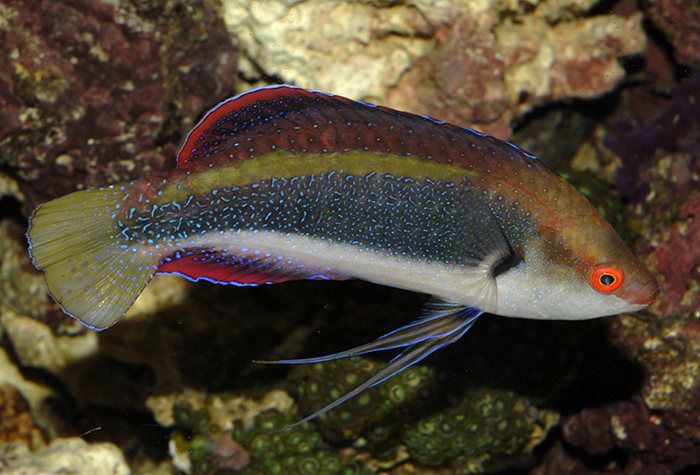
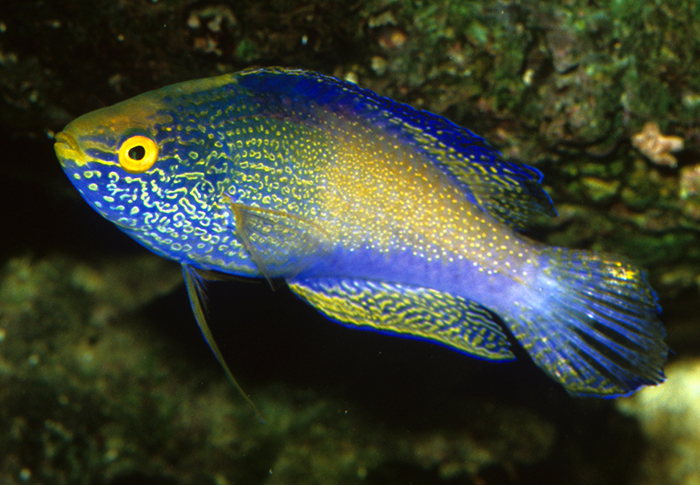

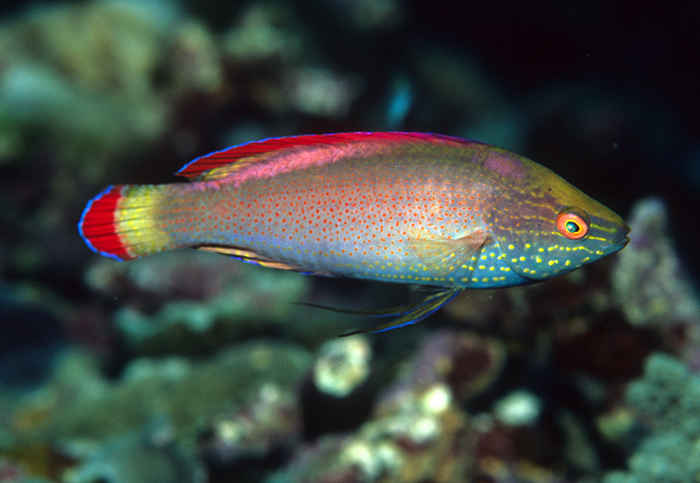
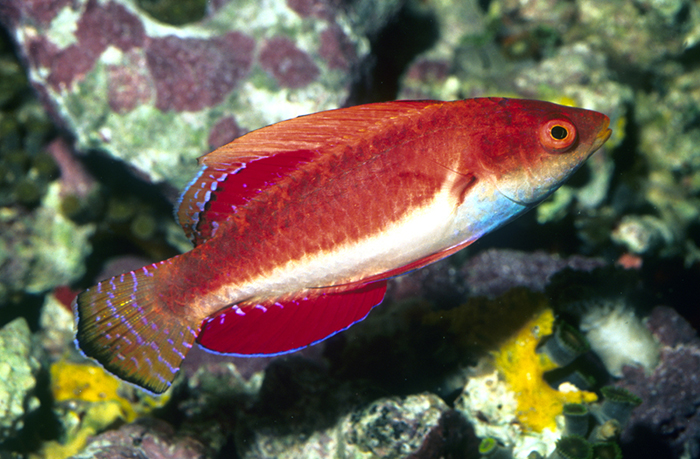
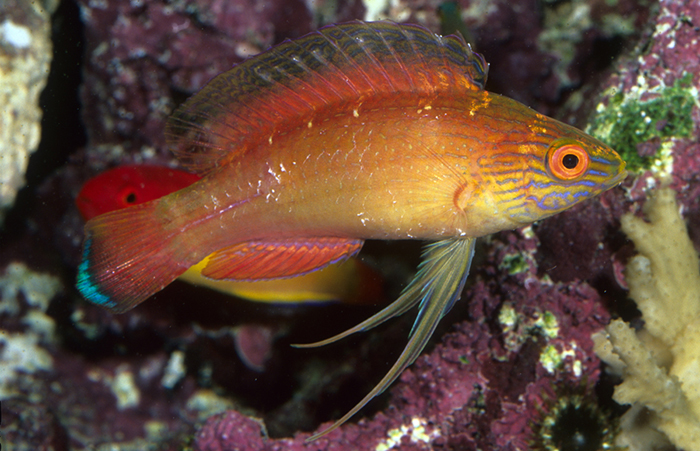

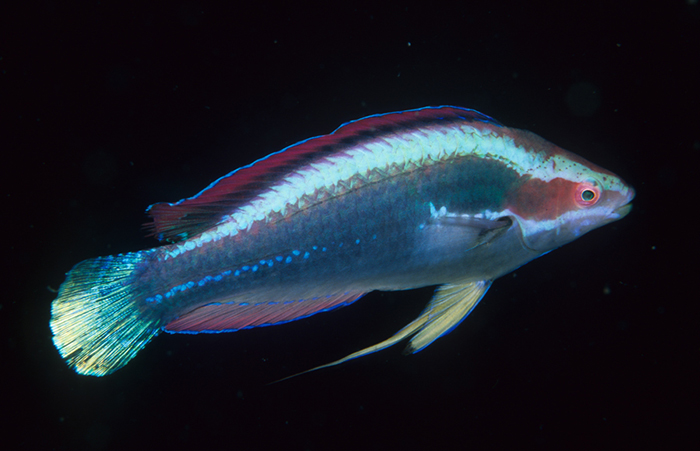
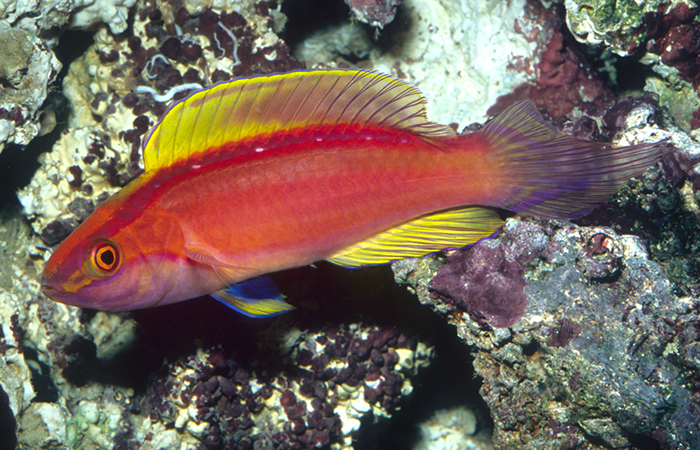

0 Comments